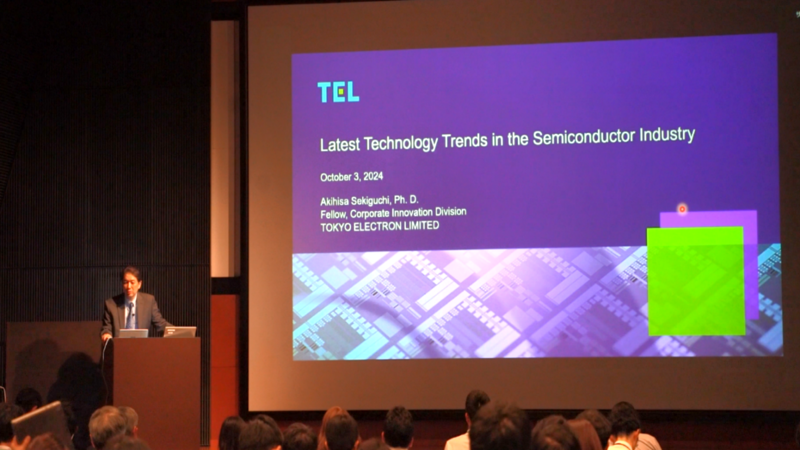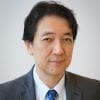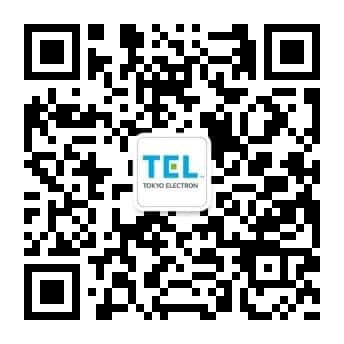Latest Technology Trends in the Semiconductor Industry
Technology

Driven by the vision of becoming “a company filled with dreams and vitality that contributes to technological innovation in semiconductors,” Tokyo Electron (TEL) has been promoting R&D on a global scale through various collaborations with academia and external institutions. This section, #Conference Presentations, will introduce the technological trends surrounding semiconductors, the conference presentations, and the voices of the presenters. This time, we would like to introduce a video of the keynote speech.
Biography
-

Dr. Akihisa Sekiguchi Fellow, Tokyo Electron
Fellow of Tokyo Electron Corporate Innovation Division. Aki is responsible for planning and executing worldwide alliance strategy for the division including programs related to AI and quantum computing. He is currently on SEMI’s Board of Industry Leaders and is a member of the CTO Forum representing TEL.
Prior to joining TEL in 2007, he worked for IBM Microelectronics Division for 17 years. As part of Semiconductor Research and Development Center, he worked on the development of FEOL, MOL, and BEOL process and equipment that enabled IBM`s DRAM and SOI based logic technologies.
Aki earned his Ph.D. in Applied Physics from Columbia University, M. Eng. and B.S. in Engineering Physics from Cornell University, and an MBA in Finance from Stern School of Business.
Discover the Future of Semiconductor Technology Trends at ADMETA Plus 2024!
In an academic conference presentation at ADMETA Plus 2024 (The Advanced Metallization Conference) , Dr. Akihisa Sekiguchi provided insights into the latest technology trends in the semiconductor industry, discussing both the current status and future projections based on technology roadmap.
Experience the exhilarating wave of innovation in the semiconductor and semiconductor production equipment industry with this presentation speech. Access the presentation here and get inspired by the future that awaits. Below is a brief summary.
State of the ICT industry
In the presentation, Dr. Akihisa Sekiguchi discussed the latest technology trends in the semiconductor industry, emphasizing significant growth projections. He highlighted that the semiconductor market is currently valued at approximately $530 billion for the calendar year 2024 and is projected to exceed $1 trillion by 2030, driven by massive global investments in new semiconductor fabs. The industry is undergoing a technological disruption, moving from the first wave driven by IoT to a second wave linked to AI. Ultimately, it's predicted to reach a market of $5 trillion by 2050, largely driven by quantum technology.
Dr. Sekiguchi emphasized the importance of infrastructure, including the internet and software applications, that supports industry growth. The data traffic is surging, fueled by the proliferation of machines that generate vast amounts of data, necessitating efficient data analysis. A significant part of the growth is attributed to AI-related applications, with semiconductor sales projected to grow at a compounded annual rate of 30% in the next five years. He discussed how generative AI is pushing for larger models that require more chip capacity. Latest chips, like those in smartphones, contain about 16 billion transistors, which is equivalent to a supercomputer from about 10-15 years ago.
However, generative AI requires even larger-capacity chips, such as server chips, with around 80 billion transistors. As demands for performance increase, the industry is moving towards advanced process nodes, transitioning from 4 nm to 2 nm technology, which increases transistor counts from 80 billion to about 200 billion. Despite advancements in scaling down technology, die sizes are increasing, and there is a growing need for high bandwidth memory.
Semiconductors and Sustainability: Net Zero
Dr. Sekiguchi discussed significant issues facing the semiconductor industry, especially concerning energy consumption. In 2020-2021, the industry experienced a high growth rate of 26% annually, raising concerns about future energy usage. He indicated that by 2045, the industry could potentially consume all the world’s energy, highlighting the urgent need for more energy-efficient devices.
Current data shows that energy consumption by the semiconductor industry is increasingly serious today, not just a future concern. Additionally, there are environmental issues related to PFAS, prompting efforts to find safer alternatives. As a leading company of semiconductor production equipment, TEL aims to achieve net-zero for scopes 1, 2, and 3 emissions by 2040. He emphasized the need for collaboration to tackle challenges while advancing technology.
Semiconductor Device Technology Trends and Challenges
Dr. Sekiguchi discussed advancements in semiconductor technology, focusing on physical scaling and advanced packaging. He referenced Moore's Law, which states that the number of transistors on integrated circuits should double every two years. He highlighted the ongoing evolution of logic devices, DRAM, and NAND technologies, with a shift toward 3D structures as dimensions shrink.
Lithography plays a crucial role in this process, requiring shorter wavelengths for imaging smaller circuit patterns. He mentioned significant collaboration with research institutions like imec to achieve these advances.
Roadmaps for future developments in logic technology indicate progress into the 2030s. The speaker also noted changes in transistor structures from FinFET to nanosheets and the consideration of new materials for interconnects. Collaborations with various institutions are essential in constructing these roadmaps for future technology advancements.
Generative AI & High Bandwidth Memory (HBM)
Dr. Sekiguchi discussed generative AI and its implications for hardware requirements. He mentioned the importance of chiplet structures that integrate CPUs and GPUs with HBM to effectively process large-scale models. Achieving optimal hardware performance involves not just enhancing logic capabilities but also increasing memory bandwidth.
He introduced the concept of the roofline model, emphasizing the need to align algorithms with available memory and logic resources to maximize efficiency. However, a significant challenge is that the power per transistor isn't decreasing as quickly as transistor density increases, leading to higher power density issues.
NAND
Dr. Sekiguchi discussed innovations in NAND technology focused on scaling by increasing the number of cell stacks (tier). He highlighted limitations in processing, particularly related to high aspect ratio stacking, which can become transport limited at greater heights. To overcome these challenges, they've explored ways to use two-tier stacking instead of three-tier, which offers a lot of savings.
Additionally, he noted the development of a cryogenic etching process enhanced by AI algorithms to improve efficiency while reducing environmental impact. This innovation resulted in a process that makes it possible to etch straight contact holes deeper than 10μm at a rate that is 2.5 times faster than before. And because the fast etch rate is maintained over time, the technology reduces power consumption by more than 40% compared with before, allowing for a more sustainable production of NAND devices.
Advanced Packaging (Heterogeneous Integration) and The Quantum Leap
The widespread use and effectiveness of a technology that integrates various devices, particularly in AI applications, by stacking logic and DRAM circuits was also discussed. Dr. Sekiguchi mentioned that CMOS image sensors were early adopters of this technology, which is now expanding into other areas. Also, in computing, he emphasized the need to prepare for a future where high-performance computing, AI, and quantum computing work seamlessly together.
Challenges for Semiconductor Production Equipment Companies
As a leading company in semiconductor production equipment, TEL needs to address challenges such as the demand for faster and better technology while managing costs and time. He advocated for digital transformation to improve efficiency and productivity and mentions the importance of collaboration within the ecosystem. He also highlighted the significance of providing educational opportunities and supporting workforce development to shift manual tasks towards AI and automation. In summary, he emphasized that the industry values collaboration, the necessity of being aware of rapid paradigm shifts, and the importance of working together to effectively navigate innovation.



